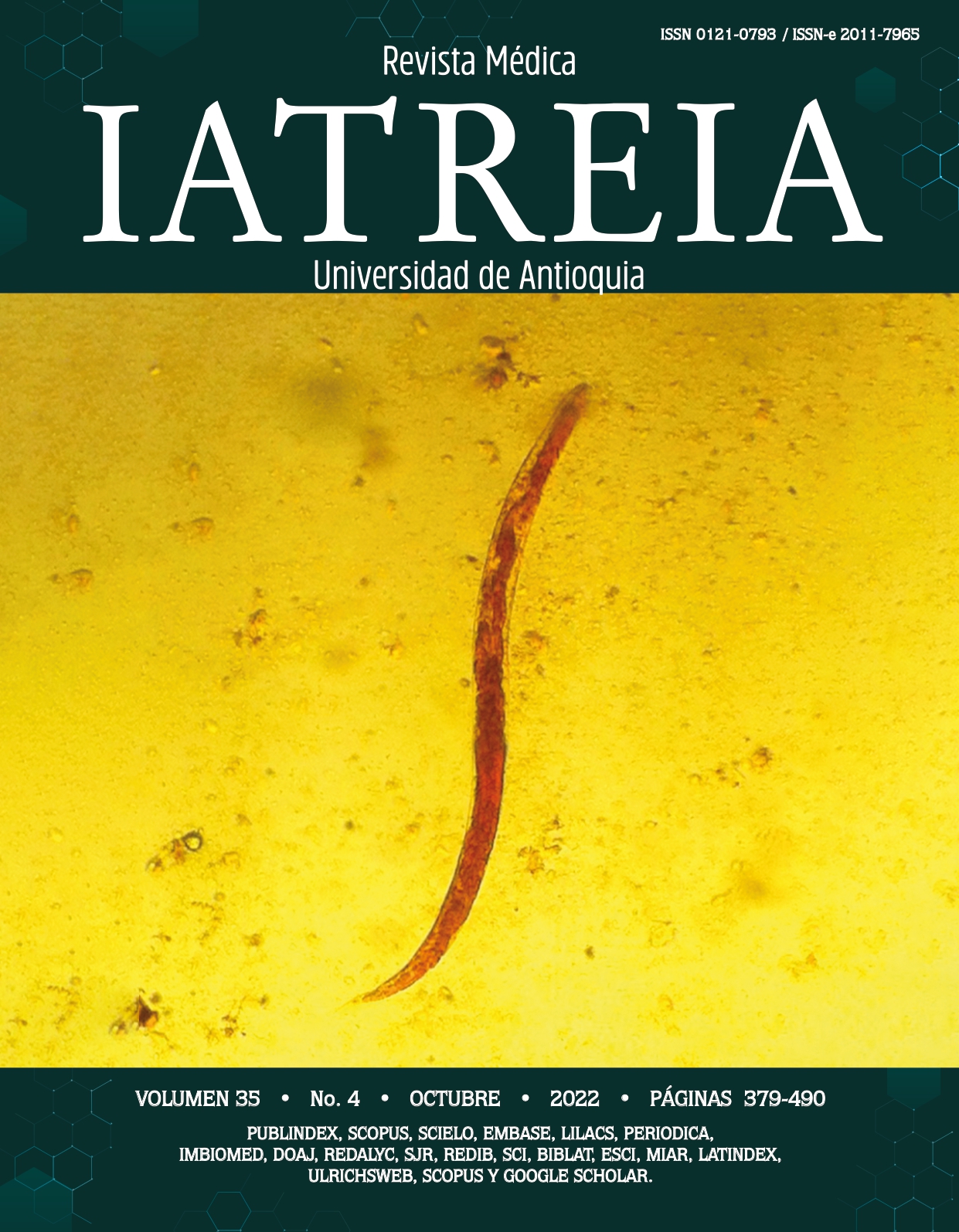Strongyloides stercoralis in the bone marrow of a person living with HIV: Case report
DOI:
https://doi.org/10.17533/udea.iatreia.178Keywords:
Immune Reconstitution Inflammatory Syndrome, Strongyloides stercoralis, StrongyloidiasisAbstract
Strongyloides stercoralis is a nematode that is characterized by causing a usually asymptomatic intestinal infection in immunocompetent individuals. However, in patients living with HIV and depending on their immune status, it can generate a hyperinfection syndrome with various complications due to dissemination to different organs.
We present the case of a 30-year-old patient with a de novo diagnosis of human immunodeficiency virus infection and lymphoproliferative disease. Within the laboratory workup, the presence of Strongyloides stercoralis was documented in the bone marrow. Despite having a CD4+ T lymphocyte count greater than 400 cells/microliter and having started treatment for this condition with ivermectin, the patient died due to a septic state associated with hyperinfection syndrome, which is why this is considered an unusual case that alerts the clinician to take into account the presence of the nematode in patients living with HIV.
Downloads
References
(1) Jongwutiwes U, Waywa D, Silpasakorn S, Wanachiwanawin D, Suputtamongkol Y. Prevalence and risk factors of acquiring Strongyloides stercoralis infection among patients attending a tertiary hospital in Thailand. Pathog Glob Health [Internet]. 2014 Apr;108(3):137-40. DOI 10.1179/2047773214Y.0000000134.
(2) Vazque-Guillamet LJ, Saul Z, Miljkovich G, Vilchez GA, Mendonca N, Gourineni V, et al. Strongyloides stercoralis Infection Among Human Immunodeficiency Virus (HIV)-Infected Patients in the United States of America: A Case Report and Review of Literature. Am J Case Rep [Internet]. 2017;18:339-346. DOI 10.12659/ajcr.902626.
(3) Cruz FO, Brandao E, Regueira-Fernandes A, Romero S, Alcantara de Souza Melo PF, Ramos-Araújo PS, et al. Características clínico-epidemiológicas de la estrongiloidiasis en pacientes portadores de co-morbilidades. Rev Chilena Infectol [Internet]. 2017 Feb;34(1):47-53. DOI 10.4067/S0716-10182017000100007.
(4) Rivas-Godoy AF, Izaguirre-González AI, Maradiaga-Reyes EF, Bu-Figueroa E, García-Aguilar JA. Estrongiloidiasis diseminada en una paciente con infección por el virus de la inmunodeficiencia humana (VIH). Medicina Interna de México [Internet]. 2018; 34(6):973-977. DOI 10.24245/mim.v34i6.1978.
(5) Marcos LA, Terashima A, Dupont HL, Gotuzzo E. Strongyloides hyperinfection syndrome: an emerging global infectious disease. Trans R Soc Trop Med Hyg [Internet]. 2008 Apr;102(4):314-8. DOI 10.1016/j.trstmh.2008.01.020.
(6) Ministerio de Salud y Protección Social, Universidad de Antioquia. Encuesta nacional de parasitismo intestinal en población escolar 2012 – 2014. Medellín: Facultad Nacional Salud Pública, Universidad de Antioquia, El Ministerio; 2015. https://www.minsalud.gov.co/sites/rid/Lists/BibliotecaDigital/RIDE/VS/PP/ET/encuesta-nacional-de-parasitismo-2012-2014.pdf
(7) Taylor CL, Subbarao V, Gayed S, Ustianowski AP. Immune reconstitution syndrome to Strongyloides stercoralis infection. AIDS [Internet]. 2007 Mar; 12;21(5):649-50. DOI 10.1097/QAD.0b013e3280117f94.
(8) Kia EB, Rahimi HR, Mirhendi H, Nilforoushan MR, Talebi A, Zahabiun F, et al. A case of fatal strongyloidiasis in a patient with chronic lymphocytic leukemia and molecular characterization of the isolate. Korean J Parasitol [Internet]. 2008 Dec; 46(4):261-3. DOI 10.3347/kjp.2008.46.4.261.
(9) Natrajan K, Medisetty M, Gawali R, Tambolkar A, Patel D, Thorat V, et al. Strongyloidosis Hyperinfection Syndrome in an HIV-Infected Patient: A Rare Manifestation of Immune Reconstitution Inflammatory Syndrome. Case Rep Infect Dis [Internet]. 2018:1-4. DOI 10.1155/2018/6870768.
(10) Mejia R, Nutman TB. Screening, prevention, and treatment for hyperinfection syndrome and disseminated infections caused by Strongyloides stercoralis. Curr Opin Infect Dis [Internet]. 2012 Aug;25(4):458-63. DOI 10.1097/QCO.0b013e3283551dbd.
(11) Brown M, Cartledge JD, Miller RF. Dissemination of Strongyloides stercoralis as an immune restoration phenomenon in an HIV-1-infected man on antiretroviral therapy. Int J STD AIDS [Internet]. 2006 Aug;17(8):560-1. DOI 10.1258/095646206778145712.
(12) Siegel MO, Simon GL. Is human immunodeficiency virus infection a risk factor for Strongyloides stercoralis hyperinfection and dissemination. PLoS Negl Trop Dis [Internet]. 2012;6(7):e1581. DOI 10.1371/journal.pntd.0001581.
(13) Nissapatorn V, Sawangjaroen N. Parasitic infections in HIV infected individuals: Diagnostic & therapeutic challenges. Indian J Med Res [Internet]. 2011;134(12):878–97. DOI 10.4103/0971-5916.92633.
(14) Sindhu, S, Toma E, Cordeiro P, Ahmad R, Morisset R, Menezes J. Relationship of in vivo and ex vivo levels of TH1 and TH2cytokines with viremia in HAART patients with and without opportunistic infections. J Med Virol [Internet]. 2006 Apr;78(4):431-9. DOI 10.1002/jmv.20558.
(15) Bar-Yoseph H, Zohar Y, Lorber M. Strongyloidiasis-Related IRIS: A Case Report and Literature Review. J Int Assoc Provid AIDS Care [Internet]. 2017;16(1):8-10. DOI 10.1177/2325957416673149.
(16) Newberry AM, Williams DN, Stauffer WM, Boulware DR, Hendel-Paterson BR, Walker PF. Strongyloides hyperinfection presenting as acute respiratory failure and gram-negative sepsis. Chest [Internet]. 2005;128(5):3681-3684. DOI 10.1378/chest.128.5.3681.
Published
How to Cite
Issue
Section
License
Copyright (c) 2022 Iatreia

This work is licensed under a Creative Commons Attribution-ShareAlike 4.0 International License.
Papers published in the journal are available for use under the Creative Commons license, specifically Attribution-NonCommercial-ShareAlike 4.0 International.
The papers must be unpublished and sent exclusively to the Journal Iatreia; the author uploading the contribution is required to submit two fully completed formats: article submission and authorship responsibility.














